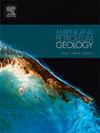中国吐鲁番-哈密盆地圣北亚海沟桑公河致密砂岩储层特征及主要控制因素
IF 3.7
2区 地球科学
Q1 GEOSCIENCES, MULTIDISCIPLINARY
引用次数: 0
摘要
吐鲁番-哈密盆地圣北亚沙格的桑公河致密砂岩油气藏是油气勘探的重点区域。然而,以往的研究主要集中在岩石学特征、物理性质和孔隙类型方面。对成岩作用、微观孔喉特征以及超压对储层的影响缺乏了解。这一知识空白对今后的研究和油气勘探造成了不利影响。本研究考察了吐鲁番-哈密盆地圣北亚沙格的桑公河致密砂岩油气藏。该研究结合薄片铸造、物性测试、高压注汞实验、低温氮气吸附实验和测井超压鉴定,对这些储层的基本特征、成因和微观孔喉特征进行了研究。在此分析基础上,研究确定了储层性质的主要控制因素,并提出了三项重要发现。首先,储层岩石主要由岩性砂岩和长石岩性砂岩组成,孔隙度在 4% 至 10% 之间,渗透率在 0.1 至 10 mD 之间,属于低孔隙度、低渗透率致密砂岩储层。其次,该储层经历了多个成岩过程,具有明显的压实性,并常见胶结和变质现象。酸性溶解是主要的溶解过程,但相对较弱。孔隙-咽喉系统的分选效果差且集中,主要是纳米级孔隙。这些孔隙包括窄颈宽体的 "墨水瓶 "孔隙和平行板状结构的裂隙孔隙。最后,储层的发育主要受沉积、溶解和超压的影响。母岩产状的特点是稳定的重矿物含量高、粒度较大、砂体层较厚。这些因素增强了储层的抗压性,促进了原生晶间孔隙的发育。此外,有机酸流体导致长石和碎石大量溶解,形成了大量二次溶解孔隙。此外,欠压实超压有助于保留原生孔隙,而碳氢化合物生成超压则延长了碳氢化合物生成期。这一时期的延长为流体迁移提供了动力,加强了储层空间的转换,并有助于碳氢化合物的积累。本文章由计算机程序翻译,如有差异,请以英文原文为准。
Characteristics and main controlling factors of the Sangonghe tight sandstone reservoirs in the Shengbei Sub-sag of the Turpan-Hami basin, China
The Sangonghe tight sandstone hydrocarbon reservoirs in the Shengbei Sub-sag of the Turpan-Hami Basin are key areas for hydrocarbon exploration. However, previous research has mostly focused on petrological characteristics, physical properties, and pore types. There is a lack of understanding regarding diagenesis, microscopic pore-throat features, and the impact of overpressure on the reservoir. This gap in knowledge poses a disadvantage for future studies and hydrocarbon exploration. This study examines the Sangonghe tight sandstone hydrocarbon reservoirs in the Shengbei Sub-sag of the Turpan-Hami Basin. It combines cast thin sections, physical property tests, high-pressure mercury injection experiments, low-temperature nitrogen adsorption experiments, and well logging overpressure identification to investigate the basic characteristics, diagenesis, and microscopic pore-throat features of these reservoirs. Based on this analysis, the study identifies the main controlling factors of the reservoir properties and presents three key findings. First, the reservoir rocks are primarily composed of lithic sandstone and feldspathic lithic sandstone with porosity ranging from 4% to 10% and permeability ranging between 0.1 and 10 mD, classifying it as a low-porosity, low-permeability tight sandstone reservoir. Second, the reservoir has undergone several diagenetic processes, with significant compaction and common occurrences of cementation and metasomatism. Acidic dissolution is the main dissolution process, but it is relatively weak. The pore-throat system exhibits poor and concentrated sorting, with nanometer-sized pores being predominant. These include 'ink-bottle' pores with narrow necks and wide bodies, and parallel plate-structured fissure pores. Finally, the development of the reservoirs is mainly influenced by sedimentation, dissolution, and overpressure. The parent rock provenance features a high content of stable heavy minerals, larger grain sizes, and thicker sand body layers. These factors enhanced the reservoir's resistance to compaction and promoted the development of primary intergranular pores. Additionally, organic acid fluids caused extensive dissolution of feldspar and lithic fragments, resulting in the formation of numerous secondary dissolution pores. Additionally, under-compaction overpressure helped preserve primary pores, while hydrocarbon generation overpressure extended the hydrocarbon generation period. This extended period provided the driving force for fluid migration, enhanced the transformation of reservoir space, and aided in hydrocarbon accumulation.
求助全文
通过发布文献求助,成功后即可免费获取论文全文。
去求助
来源期刊

Marine and Petroleum Geology
地学-地球科学综合
CiteScore
8.80
自引率
14.30%
发文量
475
审稿时长
63 days
期刊介绍:
Marine and Petroleum Geology is the pre-eminent international forum for the exchange of multidisciplinary concepts, interpretations and techniques for all concerned with marine and petroleum geology in industry, government and academia. Rapid bimonthly publication allows early communications of papers or short communications to the geoscience community.
Marine and Petroleum Geology is essential reading for geologists, geophysicists and explorationists in industry, government and academia working in the following areas: marine geology; basin analysis and evaluation; organic geochemistry; reserve/resource estimation; seismic stratigraphy; thermal models of basic evolution; sedimentary geology; continental margins; geophysical interpretation; structural geology/tectonics; formation evaluation techniques; well logging.
 求助内容:
求助内容: 应助结果提醒方式:
应助结果提醒方式:


